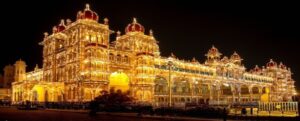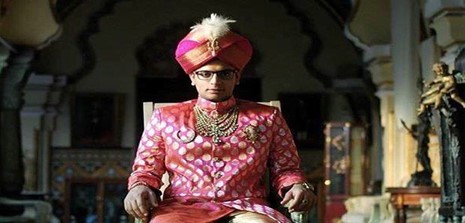The Curse Over Wadiyar: The Maharaja of Mysore
The Mysore Wadiyars are one of the most prominent royal dynasties of South India. Known for their valor, patronage of art, and devotion to Goddess Chamundeshwari, they ruled Mysore for centuries. Yet, hidden behind their grandeur lies a mysterious tale of a royal curse—a legend that continues to intrigue historians, devotees, and visitors to Mysore Palace even today.

The Origin of the Curse
The story dates back to the early 17th century when Raja Wadiyar I (ruled 1610–1617) captured the fort of Srirangapatna from the local ruler Srirangaraya, a vassal of the Vijayanagara Empire. The conquest was a turning point in Wadiyar history, for it laid the foundation of their kingdom.
However, as legend goes, during the siege, Srirangaraya’s wife, Queen Alamelamma, tried to escape with her jewels. She was known for her immense beauty and her priceless ornaments, especially a nose ring that glowed like a lamp. As Wadiyar forces pursued her, Alamelamma is said to have cursed the dynasty before leaping into the River Kaveri and drowning herself.
Her curse was chilling: “May Mysore never have children! May the lineage of the Wadiyars always suffer from a lack of natural heir s”
This pro-nouncement whether historical fact or folklore, became a shadow that lingered over the Mysore throne for centuries.
The Curse in Reality
Interestingly, history reveals a peculiar pattern. For nearly 400 years, successive generations of Wadiyars faced issues of heirship. Many kings either remained childless or had to adopt heirs from collateral branches of the family to continue the dynasty.
- Raja Wadiyar I himself died without a direct heir.
- In later centuries, several rulers of Mysore, including Chamaraja Wadiyar VIII and Krishnaraja Wadiyar III, had no natural children and had to adopt successors.
- Even in modern times, this mystery persists. The famous Jayachamarajendra Wadiyar, the last reigning Maharaja of Mysore, had only one daughter, who could not continue the lineage as per royal traditions.
The present titular king, Yaduveer Krishnadatta Chamaraja Wadiyar, was adopted in 2015 by Pramoda Devi Wadiyar after the death of her husband, Srikantadatta Narasimharaja Wadiyar, who had no children.
This consistent lack of direct heirs gave credibility to the belief that Alamelamma’s curse still looms large over the Mysore royal family.
The Jewel of Alamelamma
Adding more mystique to the legend, the jewels of Alamelamma are preserved even today at the Mysore Palace. They are displayed only on special occasions, particularly during the famous Dasara Festival.
Among them, the nose ring, which supposedly glows like a flame in the dark, continues to fascinate visitors. Some locals believe that her spirit still protects the jewels and that removing them from Mysore would bring misfortune.

Faith and Belief
For the people of Mysore, the curse is not merely a tale but part of living tradition. When childlessness struck the royal family, many turned to Chamundeshwari Temple atop Chamundi Hills, believing that the Goddess, the family’s patron deity, watches over the dynasty.
Priests and historians often debate whether the curse is real or just coincidence. Skeptics argue that hereditary health issues or dynastic marriages could explain the lack of heirs. But for devotees, Alamelamma’s final words still echo as divine truth..
The Curse Today
Though the Mysore kingdom was merged into the Indian Union in 1947, the Wadiyars continue to hold cultural and spiritual importance. The annual Dasara celebrations, led by the royal family, attract lakhs of devotees and tourists.
Yet, every time a new heir is adopted, whispers of the curse revive. The adoption of Yaduveer Krishnadatta Wadiyar in 2015 was seen by many as both a continuation of the dynasty and a reminder of Alamelamma’s enduring power.

Conclusion
The tale of the Wadiyar curse is a fascinating blend of history, folklore, and faith. Whether one believes in it or dismisses it as coincidence, there is no denying its influence on the identity of Mysore and its royal lineage. In the grandeur of Mysore Palace, in the glow of Alamelamma’s jewels, and in the spirit of the Dasara festivities, the story of the curse continues to live on—binding the past with the present in a mysterious chain of destiny.

